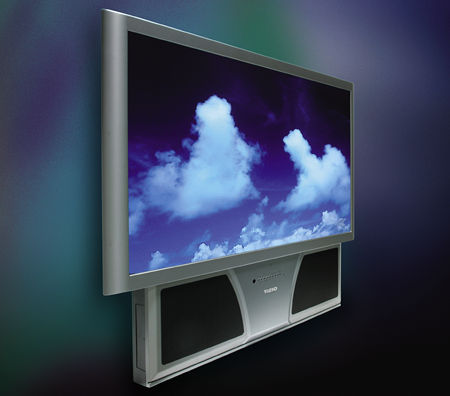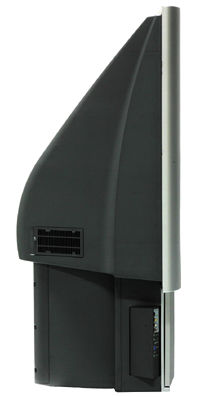V, Inc. Vizio RP56 DLP rear-projection TV

In a hurry, I grabbed a cart and flashed my membership card at the guy at the door. Rounding the digital-camera kiosk at the end of the computer aisle, I was promptly stopped in my tracks by a sleek, widescreen rear-projection TV showing an exceptionally fine-looking HD picture. Drawn like a moth to a flame, I maneuvered my big plastic cart closer. One look at the cabinet told me that this was no CRT-based set—not with such a slim profile. Hunkering down to put myself on axis with the low-height screen, I watched the Dish Network HDTV promo loop cycle through several times.
The corporate logo on the front of the set was unfamiliar, but not the small insignia on the lower left screen bezel. "Who the heck is Vizio?" I remember wondering. "And how do they manage to sell this DLP-based rear-projection set for just $2499?"
Who Are These Guys?
It turns out I was looking at the Vizio RP56 ($3299 list price), the first RPTV from industry newcomer V, Inc. This California-based company burst on the scene two years ago, at the 2003 Consumer Electronics Show, where they announced a lineup consisting of several "value-priced" plasma displays ranging from a 32-inch model ($1999) to a 50-incher ($5999), a couple of small LCD TVs, and the Bravo D1 DVD player ($199; see Scott Wilkinson's review of the Bravo D1 in the December 2003 Stereophile Guide to Home Theater).
The RP56 was announced in June 2004. This 56-inch widescreen set incorporates Texas Instruments' Digital Light Processing (DLP) technology, specifically the single-chip HD2 engine. Resolution is 1280x720 pixels, and all of the common video signal formats are supported, including 1080i, 720p, 480p, and 480i. The set also accepts computer video at 1024x768, 800x600, and 680x480 resolutions. As with all fixed-pixel displays, an internal scaler converts all of the nonnative formats to 1280x720.
Standard 480i video signals are processed by a digital comb filter (RF and composite signals only) and Faroudja's highly regarded Directional Correction Deinterlacing (DCDi) circuit, which greatly reduces line artifacts, or "jaggies." DCDi uses a 3D motion-adaptive circuit with 3:2 and 2:2 pulldown for displaying film-sourced signals without motion artifacts.
Video Inputs
The RP56 is amply endowed in the video input department. Starting on the rear panel, there are two AV inputs with S-video, two HD-capable component-video inputs, one RGB input, and a Digital Video Interface (DVI) input with its requisite HDCP copy-protection support. The "front" inputs are actually located on the side of the cabinet, and include another RGB input, a third AV input with S-video, and two headphone jacks. The RP56 has no video outputs at all.
 When used with a matching source, such as V, Inc.'s own Bravo D1 player, the DVI input should provide even better performance than a component-video connection. Just set the DVI source component's output resolution to match the native resolution of a fixed-pixel display—in this case, 720p—and you end up with a direct digital signal path and what V, Inc. calls 1:1 Pixel Mapping. That's the theory, anyway. The reality turned out to be a bit more complex.
When used with a matching source, such as V, Inc.'s own Bravo D1 player, the DVI input should provide even better performance than a component-video connection. Just set the DVI source component's output resolution to match the native resolution of a fixed-pixel display—in this case, 720p—and you end up with a direct digital signal path and what V, Inc. calls 1:1 Pixel Mapping. That's the theory, anyway. The reality turned out to be a bit more complex.
Look and Feel
Despite its low price, there's nary a whiff of cheese about the RP56. The set's overall look and feel are excellent, if rather conventional. Everything feels solid and well constructed. The attractively styled gray plastic cabinet is less than 19 inches deep and weighs just 130 pounds. Though hardly hang-on-the-wall slim, the RP56 is positively svelte compared to a similarly sized CRT model.
I was surprised to discover that V, Inc. does not offer a matching stand for the RP56, as the cabinet's low height pretty much demands the use of one to raise the screen to the proper level for on-axis viewing by a seated person. And you definitely want to watch this (or any other) RPTV on axis, or as close to it as you can get—the light output from a high-gain screen drops off noticeably as you move away from the center. That said, the amount of hot-spotting visible on the RP56's 4.0-gain screen was much less than on many conventional RPTVs I've reviewed.
Every DLP display relies on a single, high-intensity lamp as a light source. The lamp gets extremely hot, making a cooling fan essential. The Vizio's fan makes just enough noise to be noticeable in a silent room, but it never bothered me during a show. The fan's intake grille is protected by a replaceable filter. If you plan to mount the RP56 in a custom cabinet, be sure to provide ready access to the left side of the rear panel to allow room for cleaning the filter—and, after 6000 hours, for replacing the lamp.
Single-chip DLP displays such as the RP56 use a rotating color filter wheel to separate the lamp's white light into red, green, and blue primaries. You can hear the color wheel spinning up to speed as the set warms up, which takes about 30 seconds. After that, the sound recedes to become part of the set's gentle overall background hum.
A few final quibbles: There's no way to perch a center-channel speaker atop the RP56. Any manufacturer making a set with this type of angled-top cabinet needs to offer an optional shelf that can be screwed or snapped into place to support a center speaker. A few handles or handholds would also be very welcome come moving time, as would a set of casters.
User Interface
The RP56 has a simple onscreen display (OSD)—perhaps too simple. Navigating the all-important picture controls is often downright annoying, requiring too many nonintuitive button pushes. Worse, the picture controls adjust in 5% increments, which is too coarse; I often found myself wishing for, say, a brightness setting between 40% and 45%. At least the menu seldom blocks test patterns; when it does, you can move it.
Each video input can have separate picture settings, which is great. The set also recalls the last aspect ratio used for each input. Unlike some widescreen displays, this one can apply its 4:3 aspect ratio to a 480p component input signal, which is great for watching TV shows on DVD from a progressive player.
Two remote controls are provided. The main remote is a very nice, lighted, universal preprogrammed model with limited learning capabilities. The second remote is dedicated to the set's comprehensive PIP functions. In addition to an Input button that cycles through all the video inputs, the main remote has semidirect input access buttons: A TV button selects the internal tuner, Comp alternates between the two component inputs, PC steps between the front and rear RGB inputs and the DVI input, and AV switches between the two video inputs.





























































